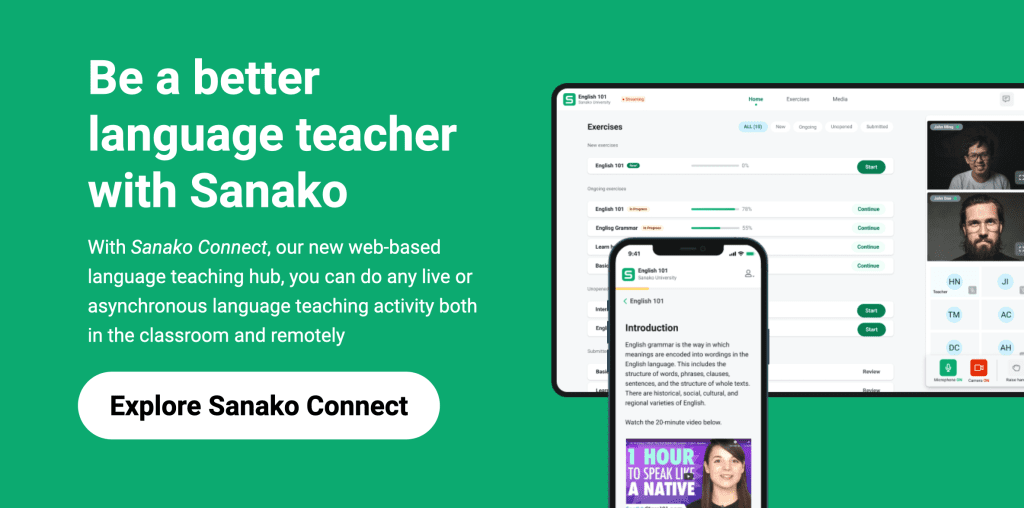As with most things in life, there are only a few areas of universal agreement in language education. One of those topics is that most educators agree that learners benefit from participating in fluency-based, meaningful, communicative speaking activities (Bygate, 2009 and Dörnyei, 2009).
Thornbury’s 2005 work goes further arguing that oral “practice makes – if not perfect – at least, fluent.” However, for students to achieve this, educators do need to find time in their lesson schedules to prioritise communicative speaking tasks. In fact, Nation and Newton (2009) suggest that lesson time on every language course should be divided into four broad (and equal) strands:
- meaning-focused input (i.e. reading and listening)
- meaning-focused output (i.e. speaking and writing)
- language-focused learning (e.g. grammar, vocabulary, pronunciation)
- fluency development of previously studied items of language through the four skills.
This would seem to suggest that approximately 25% of all classroom time should be devoted to active speaking tasks. Yet Sanako’s research and customer feedback suggest that the reality is much lower. In fact, students only spend 1 or 2% of an average lesson speaking. More specifically, additional Sanako research found that each individual student in a traditional language class of 30 students would typically only have 21 seconds of speaking time per person in an average 45 minute lesson. This is obviously insufficient to develop fluency!
How can the student speaking time be increased?
There’s a wealth of practical steps that language educators can take to address this including better use of technology, more efficient teaching approaches and an open and collaborative classroom culture. CUP’s paper on the topic (“How much time should we give to speaking practice?“) suggests that educators should refocus the time spent on other topics. The paper proposes that the answer “according to researchers is to reduce the amount of time devoted to language-focused work.”
The paper also argues that language teachers should not devote 100% of any additional time to just performing speaking tasks. It suggests that the effectiveness and impact of speaking work can be increased by maximising opportunities for feedback; giving students time to plan their speaking tasks properly, and considering how students can best reflect on the learning / speaking activities conducted.
Give your students time to think
As with any learning activity, it’s important to give students the chance to think quietly about the task they have just completed. Give them some simple prompts to work through. For example, How did it go? What did they learn? What did they find challenging? It may also be useful to give students the opportunity to repeat the task to demonstrate how well they have understood and actioned any feedback provided.
Many experts also advocate the use of self-evaluation techniques. These are usually printed questionnaires or worksheets which specifically ask students to focus on detailed aspects of the task and their spoken response (e.g accuracy, fluency, grammar, vocabulary etc.). They may also be used to capture their feedback on the task(s) that they have just completed.
Of course in most cases, speaking tasks should also provide opportunities to develop students’ listening skills. It is important that any self-reflection activities also consider their role as a listener.
As outlined in the CUP report, Goh and Burns (2012) suggest that “these reflective tasks should form an important component of classroom approaches to speaking.” They go on to specify that students’ thoughtful reflection should focus on one or more of the following points:
- Demands of the speaking tasks that learners have become aware of.
- The strategies that are useful for meeting the demands of the task.
- Learners’ informal assessment of their capabilities and performance.
- Areas of their performance that show improvement.
- Areas to be further improved.
- Plans for improving specific areas.
To that end, Goh and Burns’ work also suggests that students should keep and maintain a ‘speaking diary’ or journal.
What is a speaking diary?
One of the key ways for students to build confidence and fluency in their core language skills is to practise using them regularly. Keeping a diary is a great way to build up a regular rhythm of practice and provides evidence of their improvement and wider learning journey. It’s also a great way to revisit and reflect on the speaking tasks that students have completed in class that day.
Students can simply use the free voice recording app on their phone, or create these recordings using a language teaching/learning software tool like Sanako Connect, and a library of daily content quickly builds up. Of course, this content could also be shared with peers or teachers for comment and feedback. Students can easily critique their own audio files and identify where improvement is necessary.
The idea could also be extended to other language skills. Making a regular journal entry can work in a similar way, helping learners to quickly improve their writing skills. Some commentators suggest that there is a difference between a diary and journal entry, but what’s most important is the regular, consistent flow of creative language output. Whatever the format!
What’s the impact?
There have been a number of international studies highlighting the effectiveness of this approach to language teaching. One of the best known is a 2016 study by a Turkish professor called Ismail Yaman. His study is titled “What If There Is Nobody Around to Speak English? Then Keep Your Voice Diary“ and it saw his class of 12 voluntary ELT students keeping voice diaries as a way of extending speaking practice beyond the classroom walls.
Yaman found that: “When asked about the contribution of individual voice diaries to the alleviation of the lack-of-practice-opportunities problem, almost all of the participants (except one) evaluate keeping voice diaries as an effective means of speaking improvement. It is praised mostly for its boosting effect on self-expression skills, fluency, and pronunciation; and for its lowering effect on anxiety and stress.”
The report concluded that keeping individual voice diaries could help EFL learners. But it also recognised that there was “no equivalent substitute for the improvement of oral skills through dialogue and interaction between human beings.” Surely all language educators would agree with that!
How can Sanako help develop your students’ speaking skills?
With customers in 114 countries and our language teaching products in use in over 50,000 classrooms globally, Sanako has significant experience in improving students’ learning outcomes, particularly their speaking skills. There’s also clear evidence that Sanako’s range of digital solutions can increase students’ speaking time in an average lesson significantly.
Sanako Connect is perfectly suited for the task of building speaking skills. Educators can easily divide students into pairs or small groups for live conversation practice and role-play activities. This takes place online, so each group of students can talk simultaneously without distracting each other. Teachers can listen in or talk with different groups to assist as required. All individual conversations can be easily recorded and reviewed for feedback after the event, rather than interrupting live conversations.
Educators can also use Sanako Connect to create and share a wide variety of speaking tasks with students. These include automated pronunciation grading tasks, model imitation, oral assessments, online tests, or fill-in-the-blanks exercises – all of which can be created by educators in minutes. Automated tools enable learners to quickly receive feedback on their speech, helping them to identify where improvement is needed. All of the above help build confidence and motivation, encouraging students to persist and to improve. Students can also use Sanako Connect to create their audio or text-based speaking diaries and share these with their teachers for getting feedback.
Sanako is the global-leader in teacher-led language instruction technology. Our software supports language teachers to deliver inspiring and effective lessons. If you’d like to find out more about how Sanako’s dedicated language teaching software could transform your approach to language teaching, click here or the banner below to learn more!



